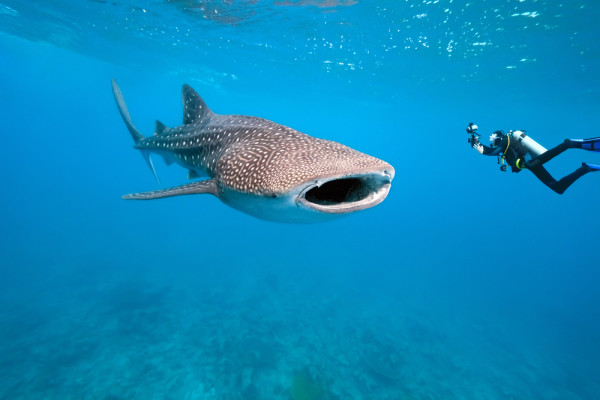
Whale sharks won’t be the only big ass vertebrate in the waters off Mexico come August! I’ll be joining Para_Sight and team for the Afuera, the massive aggregation of whale sharks in the Mexican coastal waters of the Caribbean Sea.
Admittedly in some regards this opportunity represents a departure from my research on much deeper, smaller, and spineless organisms. As anybody knows, I’m fanatical about body size. I’ve long been interested in why some animals obtain such large sizes and even more interesting why massive animals don’t get larger.
The question is not why are whales big but why are whales not bigger? The blue whales reached weights of 150 tons prewhaling. To appreciate how massive a blue whale is, consider it would take 15 school buses, around 10 tons in weight to equal one of these marine mammals. Why are there no 250 tons superwhales?
So do whale sharks only reach lengths of around 40 feet and 20 tons? Why are there no superwhale sharks?
With the largest known individual at over 20 tons, the whale shark, Rhincodon typus, is the largest species of living fish. The basking shark, the second largest fish, Cetorhinus maximus can weigh as much as 19 tons. Both species, along with megamouth sharks, are the only known species that live by filter feeding. The largest of the carnivorous and predatory sharks, the great white shark, Carcharodon carcharias, is nearly an order of magnitude smaller at a mere two tons. How has this unique lifestyle, among sharks, allowed sharks and other groups, like whales, to obtain such extreme sizes? But does this lifestyle also present an evolutionary barrier preventing no sharks bigger than this? Perhaps there is simply not enough food.
So with all we will concentrate our efforts on observing feeding behavior, biomechanics, and energy allocation of Rhincodon typus as well as the concentration and distribution of their primary food source. Combined this information will yield insights into the evolution of body of one of the ocean’s largest animals.
Special thanks to the Georgia Aquarium for the opportunity and Air Tran for the airfare!







Answer the question!
In old whaling records blue whales were 100 feet or longer. Humpbacks were up to 90 ft and 90 tons. How many years does it take for the animals to reach these lengths and weight? One hundred? Two? Whalers sought the biggest animals they could find for better cost efficiency and profit. Are we left with the smaller, younger generations? Do we have to wait over 100 years to see big animals again? I believe we do, which means WE will not ever see them, but our grandchildren might, if we can keep them on the planet.
We’ve probably affected them genetically as well, by killing off the large ones and only allowing the smaller ones to breed. It may take more than one generation before the normal ratio of sizes is restored. This is similar to the tusk size in elephants now being much smaller than it used to be. Several generations of large tusked elephants being shot, has influenced their evolution.
Couldn’t one factor be that the food supplies for them are dwindling as we overfish the oceans? They have to evolve to be smaller to survive in this new ecosystem where man is taking the lions share of the food ?
Besides some of the suggestions above, maybe there just isn’t any reason to be bigger. In other words, maybe they’re just right for their environment.
Or, maybe they will be bigger someday if they aren’t all wiped out by humans.
And one last one: If they were bigger maybe they would be negatively affected by large internal waves. Yeah, I know, bad joke. :)